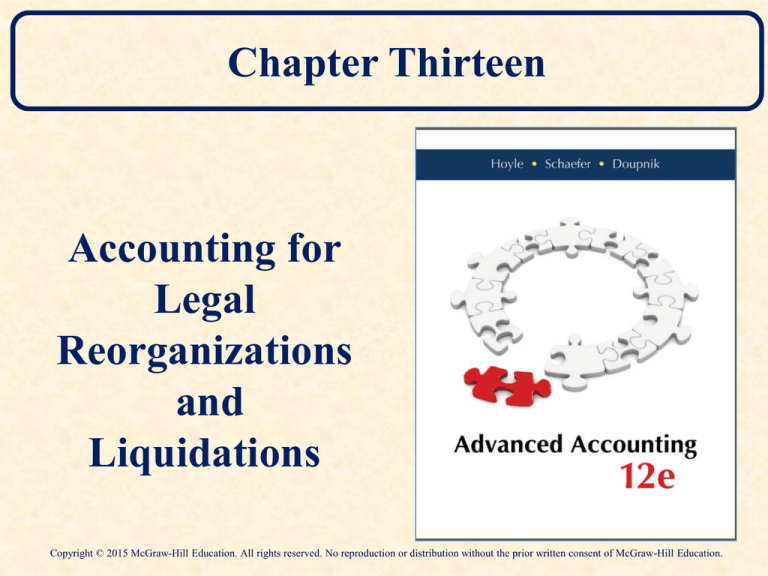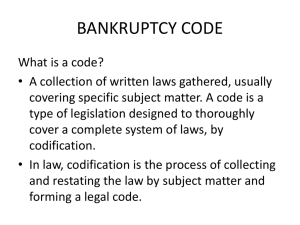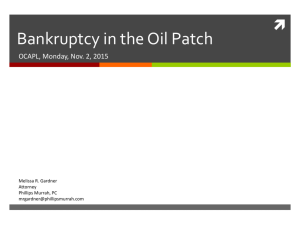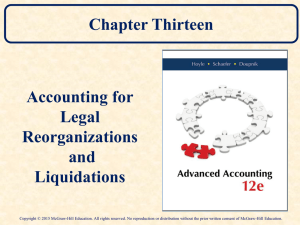
Chapter Thirteen
Accounting for
Legal
Reorganizations
and
Liquidations
Copyright © 2015 McGraw-Hill Education. All rights reserved. No reproduction or distribution without the prior written consent of McGraw-Hill Education.
Learning Objective 13-1
Describe the history and
current status of bankruptcy
and bankruptcy laws.
13-2
Bankruptcy
A basic assumption of accounting is that a business is a
going concern (will remain in business).
Occasionally, a business becomes insolvent (unable to pay
debts as they come due).
An insolvent business can either cease to exist, or can seek a
legal remedy called bankruptcy.
The Bankruptcy Reform Act of 1978 strives to achieve
two goals in connection with insolvency cases:
1) the fair distribution of assets to creditors, and
2) the discharge of an honest debtor from debt.
13-3
Learning Objective 13-2
Explain the difference between
a voluntary and involuntary
bankruptcy.
13-4
Bankruptcy
Involuntary Bankruptcy
Voluntary Bankruptcy
Creditors file petition with
the court.
Company files a petition
with courts requesting
bankruptcy.
Can force company into
liquidation under Chapter
7 or receiving protection
under Chapter 11.
When facing prospect of
severe losses or a difficult
operating environment,
companies will seek
voluntary Chapter 11.
13-5
Court Response to the Petition
Neither a voluntary nor involuntary petition automatically
creates a bankruptcy.
Bankruptcy Court may reject voluntary petitions if the
action is considered detrimental to the creditors.
Court may reject involuntary petitions unless evidence
indicates the debtor’s inability to meet obligations as they
come due (slowness of payment is NOT sufficient cause!)
If the court accepts the petition, it grants an order for
relief that halts all actions against the debtor.
A trustee is appointed to oversee the bankruptcy process.
13-6
Learning Objective 13-3
Identify the various types of
creditors as they are labeled
during a bankruptcy.
13-7
Classification of Creditors
Fully Secured
Net realizable value of the collateral exceeds
the amount of the obligation. These creditors
are completely protected by the pledged
property.
Partially Secured The value of the collateral covers only a
portion of the obligation. The remainder is
considered unsecured.
Unsecured
All other liabilities are unsecured; creditors
have no legal right to any of the debtor’s
specific assets. They are entitled to share only
in any funds that remain after all secured
claims have been settled.
13-8
Learning Objective 13-4
Describe the difference between
a Chapter 7 bankruptcy and a
Chapter 11 bankruptcy.
13-9
Liquidation or Reorganization?
How will the debtor be discharged
from its obligations?
Under Chapter 7, the debtor’s assets will be
liquidated and the proceeds distributed to
creditors (based on their priority status) OR
Under Chapter 11, the debtor will be permitted
to reorganize and continue operations.
(These “chapters” refer to the relevant sections
of the Bankruptcy Reform Act)
13-10
Learning Objective 13-5
Account for a company as
it enters bankruptcy
13-11
Statement of Financial Affairs
To begin bankruptcy proceedings, the debtor
normally prepares a statement of financial
affairs.
This schedule provides information on the
company’s current financial position to help all
parties determine the actions to take.
It is especially important to unsecured creditors
to decide whether to push for reorganization or
liquidation.
13-12
Statement of Financial Affairs
Debtor’s assets and liabilities are reported according
to the classifications relevant to a liquidation.
Assets labeled as:
Pledged with fully
secured creditors.
Pledged with partially
secured creditors.
Available for priority
liabilities and unsecured
creditors.
Debts labeled as:
Liabilities with
priority.
Fully secured
creditors.
Partially secured
creditors.
Unsecured creditors.
13-13
Learning Objective 13-6
Account for the liquidation of
a company in bankruptcy
especially when using the
liquidation basis of accounting.
13-14
Liquidation Chapter 7 Bankruptcy
Interim Trustee is appointed by court.
Changes locks, and secures assets and records.
Compiles all financial records.
Obtains possession of all corporate records.
1.
2. A committee of 3 - 11 unsecured creditors is appointed to
help protect the group’s interest.
Selection of committee helps ensure fairness and protect
the creditor group’s interests.
Consults with trustee concerning estate administration
Makes recommendations regarding trustee’s performance
Submits questions affecting estate administration to court
13-15
Liquidation Basis of Accounting
April 2013 - FASB issued Accounting Standards Update
No. 2013‐07: “Liquidation Basis of Accounting,” which is
to take affect for annual reporting periods beginning
after December 15, 2013.
Liquidation basis is first applied when liquidation
becomes imminent, that is:
1. when a plan has been approved by the court or by
people who have such authority and
2. the chance that the plan will be blocked or that the
entity will return from liquidation is remote.
Proper approval of the plan is usually the point at which
the liquidation basis becomes required by U.S. GAAP.
13-16
Liquidation Basis of Accounting
Financial reporting for the liquidating entity:
must include a statement of changes in net assets in
liquidation to investors and other claimants.
An income statement or a statement of
comprehensive income serves little purpose.
Company must issue a statement of net assets in
liquidation to allow all interested parties to gain
information about the net assets available for
distribution.
13-17
Learning Objective 13-7
List the provisions that are
often found in a bankruptcy
reorganization plan.
13-18
Reorganization Chapter 11 Bankruptcy
The company is temporarily protected from its creditors.
Creditors are encouraged to negotiate new terms with the
company.
Control of the company is normally maintained by the
owners (“debtor in possession”)
Workers keep their jobs.
Suppliers keep their customers.
Customers maintain their source of supply.
A plan of reorganization must be put forth within 120 days
and approved within 180 days by the debtor in possession.
13-19
Reorganization Chapter 11 Bankruptcy
Acceptance of reorganization plan requires approval by:
Two-thirds of the dollar amount and more than
one-half of the creditors who vote
Two-thirds of each class of stockholders who vote
Confirmation by the court
The court can also force acceptance of a plan that
was voted down (known as a “cram down”).
As a final alternative, the court can convert a
Chapter 11 Bankruptcy to a Chapter 7 Liquidation
at any time.
13-20
Learning Objective 13-8
Account for a company as it
moves through reorganization.
13-21
Financial Reporting
During Reorganization
FASB’s Accounting Standards Codification Topic 852,
Reorganizations, requires financial statements be prepared:
During the reorganization and
When entity emerges from reorganization.
Gains, losses, revenues and expenses of reorganization are
reported separately from normal operations on the
income statement.
Assets are still reported at book value.
Liabilities are shown as current versus non-current
Except for liabilities subject to reduction - reported
separately at the amount of the claims.
13-22
Learning Objective 13-9
Describe the financial
reporting for a company that
successfully exits bankruptcy
as a reorganized entity.
13-23
Fresh Start Reporting
When a company emerges from Chapter 11, GAAP permits
fresh start reporting if two conditions are met:
1. The reorganization (or market) value of the assets are less than
the total of the allowed claims as of the date of the order for relief
plus any subsequent liabilities.
2. Original owners are left with less than 50% of voting stock.
Assets are restated to individual current value.
Liabilities (except deferred income taxes) are stated at present
value of future cash payments.
Normally, APIC is adjusted to balance.
Retained Earnings is set to zero.
13-24






